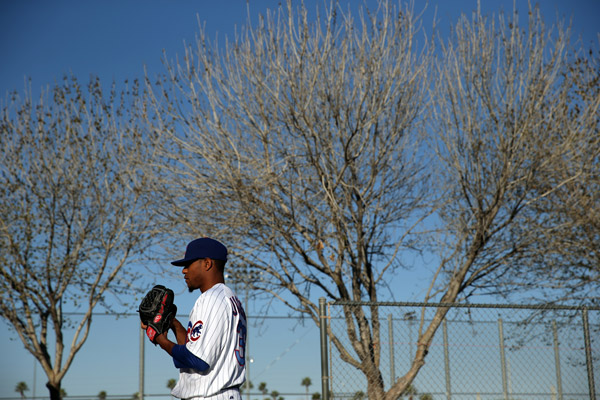
Scott Strazzante/Chicago Tribune
When Theo Epstein and Jed Hoyer began their Chicago reign, they came in to a team with a high payroll and diminshed expectations, with the idea that the profitable but indebted team wouldn't give them the long leash Jim Hendry used on expensive albatrosses like Alfonso Soriano. And so far that's been the case—most of their pickups have been modestly priced, above-average players like Scott Baker, Scott Feldman, and David DeJesus, in about the $5 million dollar range.
The one exception is Edwin Jackson, a respectable, effective journeyman pitcher. For Jackson, the Cubs laid out $13 million this season, making him their second-highest paid player this year behind Soriano. So far he's 0-5 (the second-most losses for pitchers with no wins) with a 6.39 ERA (eighth-worst among major-league starting pitchers). Tom Verducci gives the Jackson signing an F for impact; Steve Rhodes writes that Jackson "looks like the Alfonso Soriano of the Theo era." Reporters are already pushing Hoyer on whether he'll move Jackson to the bullpen.
But pitching is a fickle profession. Barely-hit bloops fall in for hits; well-hit balls find fielders. A bit of luck can make a bad pitcher look masterful (you may recall Philip Humber's perfect game; he's currently the worst starting pitcher in baseball, on baseball's worst team), or a good pitcher awful, once the top-line stats are calculated.
One way to look through those stats, past a pitcher's luck and defense, is to look at statistics a pitcher can control, or at least has more control over. And by those numbers, Jackson looks mostly fine.
* His strikeout rate is high: an impressive 21.7 percent, higher than his career average of 17.7, and a tick up from last year.
* Jackson's walk rate is too high, at 10 percent, well above last year's near-low of 7.3 percent. But his career average is 9.1 percent, so it's not freakishly high. (His first-pitch strike percentage is worrisomely low—53.9 percent, where it hasn't been since Jackson was a raw, wild Dodgers prospect.)
* His swinging-strike rate is down from last year (12.2 percent to 9.5), but in line with his career average (9.5). His contact and swing rates are all pretty typical.
What's killing Jackson is that the balls hit off him are falling for hits: opponents have a .353 batting average on balls in play, the highest number of Jackson's career. That's about 50 points over his career average, and about 70 points higher than last year.
Weirder yet is that Jackson's left-on-base rate (the percentage of runners he strands) is freakishly low, at 52.3 percent, second-worst in baseball behind Roy Halladay, who just went on the DL. His career average is 70.9 percent. That's a lot of extra runs. Yet Jackson is giving up more ground balls than he ever has in his career—10 percent more—which should result in fewer runs.
Jackson isn't helping himself with his control problems, which exacerbate his bad luck. But he does seem to be the victim of some very bad luck, unless I'm missing something in the data. Jackson's ERA is 6.39; his Fielding Independent Pitching, or FIP, is 3.23. The point of FIP is to examine what a pitcher can control—home runs, walks, strikeouts, and HBPs—so the gap between ERA and FIP is one way of looking at a pitcher's performance versus the end results. And the gap between Jackson's ERA and his FIP is the second-highest in baseball, behind Philip Humber, who would be terrible even with better luck.
Jackson's FIP is 3.23, which would be a good ERA. His SIERA (another attempt to answer the same question) is 3.77; his xFIP (ditto) is 3.57. All of that suggests not only that Jackson is a better pitcher than he's been so far this year; he's also actually pitching much, much better than his ERA and won-loss record indicate.



